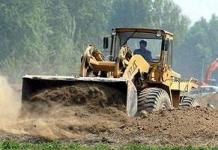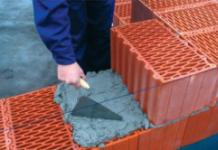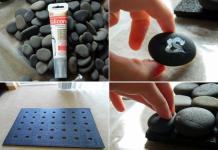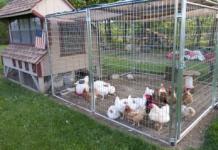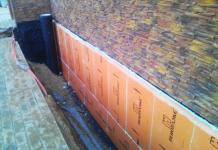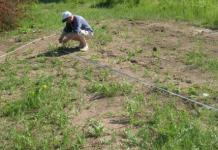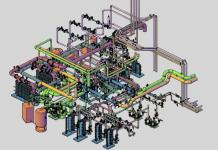Quite often, after acquiring a site, we notice that it does not have a flat surface. The presence of pits, shallow ditches or slopes makes it impossible to develop or even to use the land. How to fix the situation? It should be determined how to level the ground on the site. In this article, we will look at several ways.
Initial work
Before you level the ground on the site, you need to clean it as much as possible from stumps, weeds, all kinds of debris, such as construction. These steps are required. Our goal is to clean the area as much as possible in order to make the landscape visible. It is also necessary to determine the slope of the site.
To use a bulldozer or not?
To level the surface, equipment is often used, including a bulldozer. But if you plan to organize a garden or at least a lawn, then its use is not recommended. The main reason is that a bulldozer can destroy the fertile layer of the earth, which will subsequently have to be restored. Although in cases of dealing with large stumps, it will not be possible to do without technology. In this case, it is better to use a small tractor in order to minimize damage to the fertile layers of the earth. In general, it is up to you to decide whether to use a bulldozer by deciding how to level the ground on the site. After all, you can make a little more effort and complete the task according to all the rules.

Correct landscape alignment
If you have refused to use large equipment or the area of \u200b\u200bthe site is too small for this, then you can level it yourself. Let's consider the procedure. Let's move on to solving the question: "How to level the ground on the site with your own hands?" To do this, you will need a level, spirit level and pegs. If you want to make everything perfect, then start by removing the top layer of earth and setting it aside. Then break the plot into equal small squares, into the corners of which drive in pre-prepared pegs. Now let's move on to determining the average level of height. The easiest way is to take a peg in the middle of the site as a guide. Then, using the level and spirit level, we set the height marks on each peg. To simplify the work, a rope is pulled between the stakes. It makes it easier to identify areas that need correction. This is the easiest way to level the ground on the site. Although, as you have already noticed, this option is very laborious.

Lawn site preparation
If you are interested in how to level the ground in a lawn area, then first decide on the complexity of the work ahead. If the area has frivolous errors, then you can handle it on your own. The first way is to use a cultivator. It is necessary with its help to plow the area several times in different directions. Then, using a rake, you must manually level the ground. As you go, clean it of weed roots or small pebbles. If it is not possible to deal with weeds manually, then before cultivation the site can be treated with a special herbicide corresponding to the type of weed. After finishing work, you can safely sow the grass, and in the summer you will have the desired lawn.
Experts recommend preparing the site for the lawn in the fall. During this period, you need to walk a couple of times with a cultivator or tractor across the area. In this form, the earth remains to winter. In the spring, as soon as the soil thaws, it is necessary to cultivate the site, clean it from the remnants of weeds. A roller can be used for leveling.
After the done manipulations, we carry out the sowing of grass. Let's tell you a little secret. It is important for the first time not to walk on the sown area - until the roots of the grass get stronger. Do not forget about watering. Especially in dry weather. Watering should be carried out early in the morning or in the evening, avoiding windy weather. Thus, you can level the ground in the area under the lawn.

Responsible approach to business
If you have a lot of free time or don't like quick fixes, then this information is for you. There is a longer way to level the ground on the site. First of all, carefully inspect the area and make sure there are no problems with drainage. Perhaps the appearance of irregularities or depressions in the territory is associated with a leaking sewer or water supply. In this case, you need to contact a specialist. If there are no such problems, move on to the next question. Do you want to have a perfectly even lawn or just want to change the slope of the site? Depending on the answer, there will be various options for solving problems.
Changing the slope most often requires the use of heavy equipment. But if you only need to fill in a few recesses, then your problem is much easier to solve. It is recommended to prepare a mixture for leveling. To do this, you will need fertile soil, which can be purchased at a gardening store, sand and fertilizer. Fill the pits and lowlands with the prepared mixture and level the surface with a rake. It is better to trample down the introduced soil so that it compacts and water it. Then let the soil settle a little and after a few days the area can be sown with grass. Remember to water your lawn often so that your hard work and time don't go to waste.
In this article we will look at how to level the site in the country. Learn how to check the level of the site. Let's take a look at the step-by-step instructions. Let's compare alignment in different ways.
The optimal platform for raising the foundation and fence, arranging a vegetable garden and a garden, as well as creating a lawn area and a pool area is a flat soil surface. Suitable for the construction of the above buildings and sites are areas with a slope of not more than two degrees. However, such land is a rarity.
You can level the site yourself, provided that the differences in the soil layer do not exceed 8-9 cm.Before proceeding with the leveling of the personal plot, it is necessary to determine the purpose of the plot, namely, to allocate separate zones, for example, for the construction of a pool, lawn, garden or vegetable garden.
Experts in the earthworks industry recommend that site owners coordinate their ideas with professional land surveyors who will help analyze the mechanical structure of the soil, as well as determine the exact location of groundwater.
 The land surveyor will help determine the slope of the relief and the direction of the runoff, as well as give recommendations on the arrangement and operation of the site, taking into account the structure of the soil and the level of groundwater.
The land surveyor will help determine the slope of the relief and the direction of the runoff, as well as give recommendations on the arrangement and operation of the site, taking into account the structure of the soil and the level of groundwater. An objective analysis of the site will allow you to properly distribute the site and highlight favorable areas for building a foundation, a pool, as well as for creating lawns and garden plots. Moreover, soil analysis will determine the height of the differences in the soil layer, which will help solve the issue of moving and adding soil. Since with large differences, the owner of the site will need to think over the delivery of soil in advance and provide for special equipment.
Step by step instructions for leveling the area under the lawn
The lawn, with dense grass covering an evenly allocated area, is an ideal place for family recreation, as well as a worthy decoration for creating any landscape composition.
An important condition for the arrangement of the lawn is a flat surface of the soil layer on the site. The lawn on a flat surface looks more aesthetically pleasing and attractive, successfully takes root and does not get wet after watering and precipitation, and also does not complicate the work of the lawn mower.
 On a flat surface of the site, the lawn is distinguished by splendor and density. In areas with drops, a lawn with bald spots is formed, since at the upper points of the soil layer the sown seeds are washed out with rains and move to the lowlands with the flow of rainwater.
On a flat surface of the site, the lawn is distinguished by splendor and density. In areas with drops, a lawn with bald spots is formed, since at the upper points of the soil layer the sown seeds are washed out with rains and move to the lowlands with the flow of rainwater. - Before leveling, the site is cleared of various debris and stones. Remove stumps, old shrubs and trees;
- After cleaning the site, remove the vegetative layer of soil (sod);
- A platform of average height is identified, which will serve as a reference point when leveling the site. If the plans raise the surface of the site, then the highest point is taken, from which it will be necessary to build off when leveling;
- The high points of the site are determined, marked with special pegs for further cutting of the soil layer;
- Prepare several pegs that will serve as guidelines for leveling the soil. The first peg is set at the selected point.
 The height of the peg should be 10-12 cm higher than the highest point on the site.
The height of the peg should be 10-12 cm higher than the highest point on the site. - With the help of pegs, it is necessary to form squares measuring 1x1m. With sharp changes in the soil, squares should be formed at a distance of 50x50 cm;
- To create a single horizontal plane, check the tops of the squares using the building level.
Broken and aligned squares in a single horizontal plane will allow you to visually determine the elevated and lowland areas. The lowlands are filled with fertile soil, the elevated areas are cut off with a shovel. The finished area is leveled with a rake.
Tip #1: A leveled area should not be seeded with lawn mixture for 2-2.5 weeks. The soil during this time should be settled and enriched with beneficial microorganisms.
When using special equipment to level the site
It is advisable to use special equipment for leveling areas in areas with a large area. Techniques are also involved in cases where the sections have the following types of obstacles:
- old foundation;
- concrete plates;
- fittings and poles;
- massive stumps;
- trees and shrubs;
- old buildings.
For cleaning obstacles, mini-equipment is used - bulldozers, tractors, graders, excavators, cultivators. To attract equipment, site owners need to contact a specialized company. Consider the approximate prices for the implementation of land works with the participation of mini-equipment:
The choice of equipment depends on the degree of complexity of the work on the site. With the help of special equipment, the following types of work are performed:
- Remove ravines;
- Fall asleep pits, pits, trenches;
- Level large mounds of soil;
- Remove obstacles.
In the table, we consider the advantages and disadvantages of two types of special equipment, with the help of which a number of measures are taken to level the soil:
| Types of equipment | Advantages | Flaws |
| Cultivator | Compact dimensions, which makes it easier to work on large areas when processing horizontal soil layers. It is used for finishing soil cultivation and weed removal. | Preliminary preparation of the soil is required - removal of stones and debris. |
| Tractor | Does not require soil preparation. Ideal for rough work. Suitable for large areas. | Poorly levels the surface of the soil, pits and hills remain after processing. The density of the topsoil increases. |
Instructions for leveling the site for the garden and garden
When creating garden plots, it is necessary to adhere to the general rules related to leveling the land area. However, the requirements for evenness of the site are low and all land work can be carried out independently. There are two ways to level landing areas:
Method number 1. This method is designed for areas with a small area. It is used in the presence of fertile soil on the site.
- Remove the top layer of soil and spread along one edge of the site;
- Elevations are cut off with a shovel and pits and lowlands are covered with the same soil;
- The accumulated fertile soil along the edge is evenly distributed over the site.
After 12-15 days, the site can be used for planting. However, before planting, it is recommended to once again walk on the soil with a rake.
Method number 2. This method is intended for areas with a large area. It is used in the presence of a huge amount of weeds.
- The soil must be plowed twice. The first plowing is carried out in the longitudinal direction. The second - in the transverse;
- Connect a cultivator to remove weeds with roots. The cultivator is passed twice;
- After removing the weeds, they pass through the soil with a walk-behind tractor. You can also roll the soil with a barrel of water.
 To remove air pockets from the soil, you need to walk the walk-behind tractor along the site in two directions - in the transverse and longitudinal.
To remove air pockets from the soil, you need to walk the walk-behind tractor along the site in two directions - in the transverse and longitudinal. Tip #2: You can make your own soil compacting equipment. To do this, it is enough to purchase a metal barrel, pour it with ready-made cement mortar, close it tightly with a lid and let it stand for about a day.
How to level a summer cottage under a fence
Building a fence on a site with an uneven surface is quite problematic. There are 2 ways to solve this problem:
- The erection of a fence that will follow the contours of the relief of the site;
- The construction of the fence on the principle of "steps".
The stepped version of the construction of the fence is due to the installation of special sections with different heights. Such fences are made of profiled sheets. The lower part of the sheets is adjusted parallel to the soil level. Each subsequent section will be located below the previous one, which compensates for the slope of the site.
 To build a fence without "steps", you must first level the site. A fence with "steps" does not require soil preparation.
To build a fence without "steps", you must first level the site. A fence with "steps" does not require soil preparation. Leveling the area for the pool
The soil under the frame pool is compacted in the transverse and longitudinal direction. When installing the pool on loose and mixed soils, it is necessary to tamp and pour concrete mortar. Concrete solution will eliminate any distortion of the structure. On clay soils, after removing the top layer, the surface is covered with a layer of geotextile and sprinkled with sand without stones and other inclusions. This will prevent the grass from sprouting.
 It is not recommended to install a frame pool on a cleared area from old buildings, as well as on creeping loose soils.
It is not recommended to install a frame pool on a cleared area from old buildings, as well as on creeping loose soils. How to level the area under the foundation
The foundation requires an almost perfectly flat surface. First of all, it is necessary to clear the area under the foundation of debris, remove the old rhizomes of trees and shrubs. Then remove the top layer of soil.
The thickness of the top layer cut depends on the mechanical structure of the soil, on average, a soil layer of at least 5 cm is removed. The soil layer should not be thrown away after harvesting, it is useful for filling voids that form during the construction of the foundation.
The preparatory measures for leveling the site for the foundation include the removal of hills (knolls, hills) and backfilling of the pits. After the soil on the site is well tamped.
In the table, we consider the types of soil and their features when building a foundation:
Before proceeding with the leveling of the site, it is recommended to refer to the geodetic instrument. Such a device will accurately calculate the difference between the upper and lower points of the surface.
For leveling, you can use special equipment such as a mini-tractor with a cutter, plow and rake. However, a tractor can be used provided that tillage will take place on a site where there are no trees and other structures. If the site does not allow the tractor to be involved in land work, then it is better to use a cultivator.
Serious mistakes made by site owners when leveling:
- They leave small hills and valleys when arranging a lawn lawn, which leads to flooding of the lawn after rain or with heavy watering;
- The procedure for leveling the site is carried out in rainy weather;
- Alignment of the site proceeds "by eye" without establishing beacons and determining the lower and upper points on the site.
How to level the plot in the country: frequently asked questions
Question #1. What difference in the soil layer on the site is acceptable for the construction of a strip or pile foundation?
Answer: When erecting a strip and pile foundation, a height difference of 0.5 m is allowed.
Question #2. What soil is suitable for leveling the site for the foundation?
Question #3. How and how is the soil treated from weeds and pests after leveling the site?
Answer: If the personal plot is covered with perennial weeds, it is necessary to remove the top layer of plant soil with a bayonet shovel. The thickness of the soil must be at least 5 cm. After cleaning, the soil is treated with preparations - herbicides. Herbicide treatment should be carried out during the period of active growth of weeds. After treatment, cultivated plants are planted after 7 weeks.
Question #4. How to get rid of pests on a leveled area?
Answer: Leveled soil is treated with steam. This method ensures the rapid destruction of bacteria, fungi and nematodes. Moreover, steam tillage destroys weeds and their seeds.
Face with problems of uneven ground: slopes, pits, ruts. Some landowners, dreaming about how to level the site, think that it is very expensive to do this, and it will take a lot of effort, time and material resources. Of course, everything can be fixed by using the services of one of the landscaping firms, or with the help of hired workers. But you can try to level the terrain yourself. Of course, this will require certain material and physical costs, but on the other hand, you will save a lot of money that will be useful for repairing a house or sewerage, for example.
Expediency
Before leveling the site, think about the appropriateness of these actions. Indeed, sometimes it will be easier to beat the unevenness of the terrain or successfully hide them with the help of a broken flower bed or planted currant bushes. Also useful (and even now in fashion) are rock gardens, crooked fairy-tale paths, decorative ponds. With this design, you can hide any unevenness in the landscape. If excavation is still inevitable, proceed with it wisely, having developed an action plan in advance and calculating the approximate costs. After all, who wants to spend a long time among the "excavations" that dragged on for an indefinite time.

What tools will be required?
Before leveling the site in the country, you need to purchase some useful tools.
- Fan rake for loosening the earth.
- Shovels: bayonet and shovel.
- Wheelbarrow for removal of soil and garbage.
- Chopper and garden rake.
- Several long (more than two meters) wooden bars.
- Wooden pegs to hammer into the ground, marking the territory.
- Building level.
- Rope, wire, broom and other necessary little things.
Preparatory work
Before leveling the site with your own hands, you need to do certain preparatory work that will contribute to your further actions.

Main works
Now, having completed the preparation, you can proceed to the main part of the project "How to level the site yourself."
- Visually determine whether there are bumps and pits on the marked area. we use the building level and prepared wooden blocks for work. We remove the hills with a bayonet shovel, making chopping movements (especially in cases where there are roots in the ground). Holes, if they are small, can be immediately covered with earth removed from the hillocks, thus leveling the landscape. If it is not enough, the soil will have to be purchased (it is sold in specialized stores).
- Next - we level the ground over the site using a rake (if available - a cultivator). So that the soil does not sag, we tamp it down with a special weighting projectile such as a small skating rink. You can borrow it from the builders, or you can make it yourself. To do this, pour sand, gravel into an ordinary barrel, fill it with water and carefully close it. We put the barrel on its side and roll it around the site. Thus, the earth is compacted and well leveled. As a result, even after a spring flood, for example, the soil retains its shape.

- Before leveling a piece of land in a country house or in private ownership, analyze the soil that is located there. If you need a fertile layer for gardening and growing plants, and the soil is of poor quality, you need to create it artificially. Buy good soil. The thickness must be at least forty centimeters.
- If the earth is too clayey, you need to buy sand and scatter it throughout the site. After - level with a rake and roll with a weighting projectile. So the sand will mix with the soil and acquire a dense structure.
- If the territory is too large, you can not do without special equipment: a bulldozer and a tractor. In order not to pay too much money for renting equipment, first set specific tasks and calculate the mechanism for their implementation. The finishing touches can also be done by hand. Now you know what is needed in order to level the site. The price of the issue is cost savings and moral satisfaction from the work done.
The optimal place for building a house, the location of a garden plot, lawn, flower beds and a vegetable garden is considered to be a smooth and even surface. You can allow a slight slope towards the south, but not more than two degrees. Of course, such a site is a rarity, and most often, before you start landscaping the territory of a summer cottage, you need to take measures to level the site.
Why is alignment done?
The land on the territory of each site is almost always far from even coverage. But many owners of country houses think about leveling the land only when they need to make a beautiful lawn. However, this is not the main reason why you need to level the area and make it even. Alignment can be done for three purposes:

A flat area is the main condition for the formation of a beautiful lawn on the site. A smooth surface is important for several reasons:

Site preparation
 Before you start leveling the site, you must first prepare the ground well for such a process. First you need to correctly mark the main boundaries of the site. The easiest way to do this is to drive simple pegs into the corners of the area to be leveled, and then you need to connect them with a rope or a special ribbon. Next, you need to thoroughly clean the site from excess debris, trees, snags, temporary structures, shrubs - from everything that will interfere with normal operation.
Before you start leveling the site, you must first prepare the ground well for such a process. First you need to correctly mark the main boundaries of the site. The easiest way to do this is to drive simple pegs into the corners of the area to be leveled, and then you need to connect them with a rope or a special ribbon. Next, you need to thoroughly clean the site from excess debris, trees, snags, temporary structures, shrubs - from everything that will interfere with normal operation.
Already at this stage, you can start working both with your own hands and use the help of special machines.
If the area for leveling is small in size, then simply placing stakes on its borders will be enough. If such a territory is of medium or large size, then it is additionally necessary to divide it into smaller sections. Such an operation should be carried out only if the earth will be leveled by its own efforts without the use of special equipment. Pegs with ropes will simply interfere when working with large equipment.
For a rectangular area, 9 identical squares are most often distinguished (three rows, three in each). If the leveling pad has the shape of a polygonal figure, then additional sections are also added to the square sectors. The delimitation of such areas also takes place with the help of pegs. They are connected by a rope, which should run parallel to the future flat area. This will become the main reference point for alignment.
Site leveling process
 When the preparation for such a process is over, you can proceed to the alignment procedure itself. It can be carried out manually, using special country tools, or you can use special machines for this (cultivators, tractors, etc.). You can also cope with such a task in a small area without any problems using a simple shovel, rake, wheelbarrow and other additional tools that are in the barn. In case of their absence, you can ask neighbors for some of them. But in large areas without special equipment it will be difficult.
When the preparation for such a process is over, you can proceed to the alignment procedure itself. It can be carried out manually, using special country tools, or you can use special machines for this (cultivators, tractors, etc.). You can also cope with such a task in a small area without any problems using a simple shovel, rake, wheelbarrow and other additional tools that are in the barn. In case of their absence, you can ask neighbors for some of them. But in large areas without special equipment it will be difficult.
After you need to understand what to do with the fertile land. If there is some kind of slope on the site, then it should not be touched for a while, but only the lower layer of soil should be leveled. After that, the fertile soil can be returned to its previous place. When carrying out earthwork with the help of special devices, it will be much easier to acquire a new topsoil, and at the end of the work, simply lay it on top.
If a house or other summer cottages is being built on a certain site, then there is simply no point in laying fertile soil there. In this case, you can simply raise the soil to the desired height with the help of sprinkling.
Experts advise starting work on leveling the site in sunny weather without strong winds, when the ground is well dried. It will be much easier to work with it, and the absence of precipitation and strong wind will help not to breed excess dirt on the site.
Do-it-yourself site leveling
This method of leveling the area will take a lot of the owner's free time. But the summer resident can cope with such work on his own or invite friends and neighbors to help. In this case, you do not have to spend your money on paying for the rental of construction machines and for the work of craftsmen:

 The next step will be self-tamping the earth. To do this, you need to use a hand roller or its alternative. You can purchase it, ask a neighbor, or make its own analogue, for example, from a flat iron can filled with liquid. Run the roller along the surface of the territory, across, then check the evenness of the ground. The last step is to return the fertile soil to the top of the soil and then compact it.
The next step will be self-tamping the earth. To do this, you need to use a hand roller or its alternative. You can purchase it, ask a neighbor, or make its own analogue, for example, from a flat iron can filled with liquid. Run the roller along the surface of the territory, across, then check the evenness of the ground. The last step is to return the fertile soil to the top of the soil and then compact it.
Another way of leveling will be lining all sectors of the territory or individual parts with plywood sheets or some kind of flat boards. After that, you can apply a static load to them. You can press on the ground with your weight, just walking on the boards, overlay with large stones or heavy reinforcement. For better compaction of the earth, you can leave such a load for several days.
If the dacha is small in area, and the irregularities themselves are not striking, then it is enough to simply redistribute the upper layers of the soil, and then compact them well.
An unusual method for leveling the area will be a wooden vertical staircase. To do this, you just need to tie one tight rope to each end of the ladder, and then walk with such weapons through the area with bumps. The ladder weighs quite a lot, so it will do a good job of leveling the ground on the site.
Use of construction equipment
This method of alignment is faster and simpler, since it does not require the involvement of physical forces from the summer resident. The evenness of the earth with this method will be much better than with independent work. But such an alignment will cost many times more, since in this case you will have to pay for the rental of equipment. You will also have to call in professional builders at a high rate.
First you need to draw up a general plan for the leveling work and understand what equipment will be needed for this, depending on the type of irregularities. The first step for leveling the site will be the removal of the top fertile layer of the earth with the help of tractors, followed by its removal to an unused area of the territory. The earth should not interfere with the work.
After the process of eliminating all irregularities and pits begins. Soil is removed from the hills and goes into pits and strong potholes. The leveling of the site is carried out by a tractor or a bulldozer, in especially difficult places the earth is filled up with the help of an excavator or manually, with a shovel and a wheelbarrow. Excess soil is evenly distributed over the entire area of \u200b\u200bthe site for high-quality leveling.
The next step will be leveling the ground. This procedure is carried out with a mini-bulldozer, grader or cultivator. Two types of cultivators can be used: vertical - a lighter and more compact type of equipment, it is needed for leveling and processing all the upper layers of the soil, as well as horizontal, such cultivators are considered larger and more powerful, they can process more dense soil.
Non-standard situations at work
If initially the summer cottage is under a strong slope, then when it is leveled, you can create a multi-tiered territory instead of flat land, but at an appropriate angle. The principle of operation in this case is the same, but first you need to divide the territory into sections not only by squares, but also by levels. If you decide to do it yourself:

All created levels can be beautifully overlaid with large stones, between which several small paths can be drawn. You can also create a small waterfall or a simple stream. They should be sealed for greater reliability. For example, to protect stones from the ground with a waterproof fabric. With such a layout of the territory, residential buildings need to be built at a higher level.
Beautiful landscape design in the country is the result of hard work, investment of time and money.
Under no circumstances will it be possible to buy a bare plot and do without any investments.
One of the first types of work that you will need to do is earthwork.
They may include clearing the area of unwanted vegetation, dismantling old and unnecessary buildings, planning.
The latter usually consists of leveling the suburban area with giving it the desired relief with a given slope. It is to this moment that we will devote this article.
How to level the land? Issue price
Any earthwork is associated with taking out or pouring earth, moving it to the desired distance. The complexity of such work usually depends on the initial relief, the area of the planned territory, as well as on the final result that we want to get. Therefore, some part can be done with your own hands, armed with a shovel and other tools, and to complete the other part, you will need equipment and experienced specialists.
As in any other business, you can contact a specialized organization that will provide you with a full list of services and their cost. Based on this, you can weigh and analyze everything. And then decide what is best for you and what services you can afford.
The cost may vary depending on the season of work, their complexity. In winter, the price can be higher by about 200 rubles. per cube m., as the soil is frozen and it is very difficult to work with it.
You will also have to pay for the consultation and visit of a specialist to the place, which will cost 3000-4000 rubles.

If it is necessary to remove tree and shrub vegetation and stumps on the site, then the average cost for this work is about 500-1000 rubles. and more per unit, depending on the diameter of the trunk.
For leveling the site with a bulldozer, you will have to pay about 40 rubles. for 1 sq. m. If there is enough cultivator for leveling and loosening, then the price will be from 30 rubles. per sq. m. If you need to fill the site, then you also need to buy soil and pay for its delivery.

Also, do not forget that in addition to paying for the work, you will need to pay for the rental of equipment and its delivery to your site. Usually the cost is calculated for 1 hour of work.
It is advisable to hire specialists and equipment if you have a large area that is very difficult to level manually, and the lack of free time does not allow you to do this work yourself.
Leveling the land on the site with your own hands
Leveling free from buildings and a rather large area is best done using the services of the company. However, this type of work can be done independently. There are several ways to properly level the site.
If you think that you can simply level the site with a tractor, then this is a big mistake.. After such work, the surface will appear smooth only from a certain distance. In fact, there will be numerous recesses and mounds on it, which is unacceptable if you plan, for example, to create a lawn. Therefore, this work is rough.

You will need a level for do-it-yourself alignment.. It can be building or homemade. To create a level on your own, you will need a hose and two tubes (glass or plastic), which are fixed at its ends and have divisions. By drawing water into the hose, you will get an excellent level that works on the natural properties of water.
Before proceeding with the leveling, you need to remove the vegetable soil, including under the house, if you plan to build it. It is better to use sand for backfilling the site, especially if the soil is clayey. After it is leveled, a layer of fertile soil, removed earlier, is arranged on top.
However, the question arises, how to properly create a flat surface?
One way is to use wooden pegs and a level.
The sequence of work is as follows:
- We inspect our site, which we plan to level, and determine the average height point on it, relative to which we will level. However, if you wish to raise the site, you can select the highest point as the ground level.
- We drive a peg into the point so that it sticks out about 10 cm above the surface of the highest point.
- Then we break a grid of squares 1 × 1 m from it (more often or less often, depending on the steepness of the relief). We start doing this from our peg, and their tops should be located in the same horizontal area. That's what you need a level for.
- Having broken the entire grid, you will clearly see where you need to pour the earth, and where to cut off the excess. With the help of a shovel and a rake, you can easily cope with this work.
However, the considered method is suitable for small areas and for creating a horizontal platform.

Then you need to do the following:
- We determine the direction of the slope, the highest and lowest points.
- We drive in a row of pegs along the upper and lower parts of the slope, aligning them horizontally.
- We stretch the rope or fishing line in pairs between the upper and lower pegs. Thus, you will get a flat surface with a slope, formed by stretched ropes. You will only have to use a shovel and a rake to correct the surface of the earth.
If you have a cultivator, you can plow the area in several directions and level it with a rake while pulling out the weeds.
Useful video


